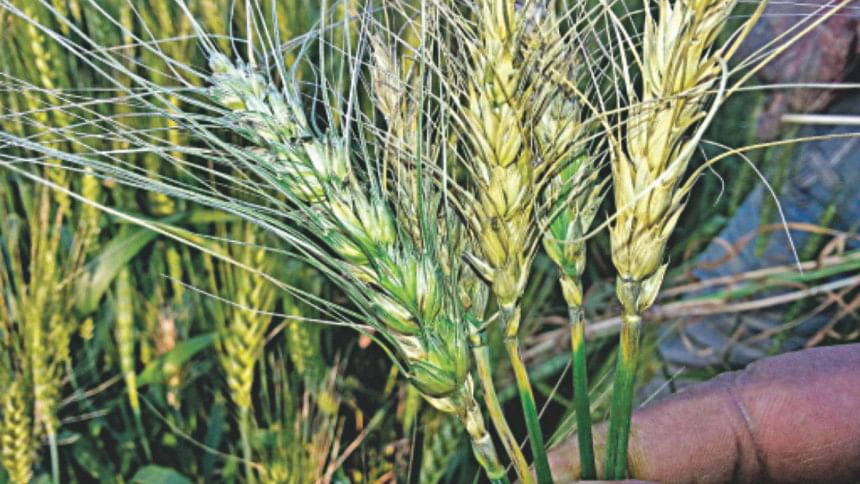Worry over wheat again

Farmers have been advised to burn the already affected plants and spray fungicide for the protection of unaffected wheat fields
A year after its first outbreak, wheat blast has reemerged and this time quite early in the season, causing fears of production loss of the country's second most important cereal after rice.
Officials confirmed The Daily Star receipt of the reports of blast resurfacing in plant leaves in some wheat fields in Meherpur.
The authorities have already ordered burning down of grains at flowering stage in five hectares of wheat fields in the district.
The first ever attack of wheat blast in Bangladesh cost the country a financial loss of at least Tk 1,800 crore in terms of lost yield last year. The blast affected over one lakh hectares of wheat fields in the eight south and southwestern districts -- Jessore, Kushtia, Chuadanga, Meherpur, Jhenidah, Magura, Barisal and Bhola in February last year, causing up to 40 percent of crop damage.
Caused by a fungus -- Magnaporthe oryzae -- wheat blast is one of the most fearsome and intractable wheat diseases in recent decades, according to the International Maize and Wheat Improvement Center (CIMMYT).
Mostly confined within the continent of South America since 1985, the disease's attack in Bangladeshi wheat fields last season was the first case of wheat blast in Asia. The blast directly strikes the ears of wheat and can shrivel and deform the grain in less than a week from the first symptoms are noticed, leaving farmers no time to act.
Though the government discouraged farmers in the eight districts from cultivating wheat this year, many still went for wheat while others preferred growing maize, pulses instead.
Department of Agricultural Extension (Dae) Deputy Director in Meherpur, Mustafizur Rahman, said farmers first informed them about blast attack in mid-February last year but this season, "we're getting symptoms of blast in wheat leaves as early as in mid-January."
Rahman said, farmers have been advised to burn the already affected ones and spray fungicide for the protection of unaffected wheat fields.
Asked about the agriculture ministry's instruction discouraging farmers from growing wheat in the district, the DAE official said many of the farmers, indeed, followed that instruction, bringing down the wheat acreage to only 3,990 hectares comparing to last year's 14,000 hectares in the district.
The parliamentary standing committee on the agriculture ministry discussed the issue of blast attack for the second consecutive year in its meeting on Thursday. Former food minister and a committee member Muhammad Abdur Razzaque told The Daily Star that there were some reports of early blast strikes in Kushtia and Meherpur.
Prof M Bahadur Meah, a preeminent plant pathologist who heads the national core committee of experts that the government had formed in the aftermath of the fungal disease last year, told The Daily Star that they were working on the field reports coming in.
M Tofazzal Islam, who heads the Biotechnology Department at Bangabandhu Sheikh Mujibur Rahman Agricultural University (BSMRAU), and has extensive works on blast study, told The Daily Star that applying a molecular diagnostic tool they have confirmed at the BSMRAU lab that blast resurfaced in some of Meherpur's wheat fields.
Prof Sophien Kamoun of the UK's Sainsbury Laboratory, who along with Prof Islam and other international experts launched -- wheatblast.org -- a website dedicated to the cause of fighting wheat blast, also tweeted on Thursday, "Wheat blast detected in Meherpur, Bangladesh. Let's hope it doesn't take off like last year.”
"If you remember there was an unlikely rain in early February last year and the dormant spores of the fungi responsible for wheat blast got triggered getting that conducive environment. Let's hope it doesn't repeat this year," Prof Islam told this correspondent emphasising on developing wheat varieties resistant to blast-causing fungi.
Talking to The Daily Star, Moin U Salam, principal research officer at the Department of Agriculture and Food, Western Australia (DAFWA), emphasised on taking timely measures so that wheat blasts did not get widespread.
The blast attack came at a time when wheat production in Bangladesh had just started picking up to 13 lakh metric tonnes (MT) in two previous years after remaining stagnant at as low as 8 to 9 lakh MT for past one decade.
Better wheat breeds developed by the Wheat Research Centre (WRC) contributed a lot in increasing domestic wheat output in recent years. Yet, Bangladesh has to import as high as 40 lakh MT of wheat from the international market to meet growing domestic demand.
Wheat production had hit a record high at 19.08 lakh MT in fiscal 1998-99. But later the acreage and production began to fall gradually as many farmers shifted to other winter crops like maize, potato and vegetables that promised higher profits.
In the aftermath of blast attack in Bangladesh's wheat fields, world's premier wheat and maize research institute, Mexico-based CIMMYT, feared that, "The consequences of a wider outbreak in South Asia could be devastating to a region of 300 million undernourished people, whose inhabitants consume over 100 million tonnes of wheat each year."
CIMMYT Director General Martin Kropff also visited Bangladesh for a better understanding of wheat blast's first Asia attack.

 For all latest news, follow The Daily Star's Google News channel.
For all latest news, follow The Daily Star's Google News channel. 



Comments